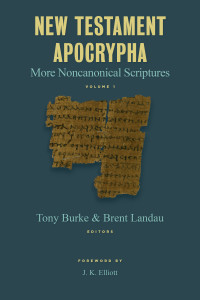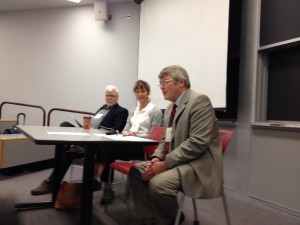2016 CSBS/CSPS More New Testament Apocrypha Panel (Part 1)
 As mentioned in my previous post, this year’s CSBS/CSPS Christian Apocrypha session was a book review panel dedicated to New Testament Apocrypha: More Noncanonical Scriptures edited by me and Brent Landau. This report on the panel, already quite late (I am the world’s slowest biblioblogger), is divided into two parts so that the post is not overly long. When the panel was planned at last year’s annual meeting, the assumption was that the book would be available by this time. Alas, the publication is not ready, though we are going through the final edits and it will be available at SBL in November. The panelists in the meantime had to read the book in electronic form. I have to remember to reward them with proper copies when the time comes. The panel was comprised of two members from each society: John Kloppenborg (University of Toronto) and Alicia Batten (Conrad Grebel College, Waterloo) from CSBS, and Robert Kitchen and Timothy Pettipiece from CSPS. The session was chaired by Emily LaFleche, a graduate student at the University of Ottawa working on the Gospel of Philip.
As mentioned in my previous post, this year’s CSBS/CSPS Christian Apocrypha session was a book review panel dedicated to New Testament Apocrypha: More Noncanonical Scriptures edited by me and Brent Landau. This report on the panel, already quite late (I am the world’s slowest biblioblogger), is divided into two parts so that the post is not overly long. When the panel was planned at last year’s annual meeting, the assumption was that the book would be available by this time. Alas, the publication is not ready, though we are going through the final edits and it will be available at SBL in November. The panelists in the meantime had to read the book in electronic form. I have to remember to reward them with proper copies when the time comes. The panel was comprised of two members from each society: John Kloppenborg (University of Toronto) and Alicia Batten (Conrad Grebel College, Waterloo) from CSBS, and Robert Kitchen and Timothy Pettipiece from CSPS. The session was chaired by Emily LaFleche, a graduate student at the University of Ottawa working on the Gospel of Philip.
Kitchen opened the session with some queries about the terms applied to the texts in the collection. Most of us in the field fuss over the modifier “New Testament” but Kitchen took more of an issue with “apocrypha” given its connotations of “‘hidden,’ ‘secret,’ and so likely heterodox,” because many of the texts in the volume are none of these things. He then remarked positively about the number of Oriental languages represented—while 14 of the texts are in Greek and 5 in Latin, there are 5 in Coptic, 5 Syriac, 2 Arabic, and 1 each in Georgian, Ethiopic, and Aramaic. He applauded the consistent template used in each contribution (a summary of contents, list of manuscripts and editions, discussion of the original language(s) and provenance, a bibliography, and finally the English translation). He then provided some comments about the Syriac texts in the volume (Revelation of the Magi, Infancy Gospel of Thomas, the Legend of the Thirty Pieces of Silver, and the History of Simon Cephas, the Chief of the Apostles), since Syriac Christianity is his principle research interest. Kitchen finished saying he was looking forward to future volumes in the series: “as for Volume 2, 3, maybe 4 of such Christian Apocrypha, we want ‘more.’”

John Kloppenborg began his review with a survey of other recent, expansive apocrypha collections and noted that their overlap with MNTA was “quite slight.” Nevertheless, he expressed concern that the series’ mandate of supplementing, not replacing, previous collections, could lead to a division in the literature between “canonical” apocrypha (i.e., the standard, early texts such as the Gospel of Thomas and the Protevangelium of James) and the “non-canonical” lesser-known texts: “It seems impractical from a publisher’s perspective to attempt a comprehensive collection of all 346 apocryphal texts listed in Geerard’s Clavis, as desirable as that might be. But steps should be taken to avoid the fragmentation of resources, which would, counterproductively lead to the further marginalization of some noncanonical texts.” That said, Kloppenborg applauded the wide scope of the collection, noting that Schneelcher’s now-infamous separation of apocrypha from hagiography was an artificial distinction (even New Testament texts, he said, are hagiography since they feature stories and teachings of saints).
Kloppenborg mentioned also the recently-launched e-Clavis: Christian Apocrypha resource, surprised that it is not mentioned at all in MNTA (note to self: email publisher to remedy this!). “While MNTA is a worthy publication,” he said, “one hopes that the clavis will be everyone’s first stop in studying Christian Apocrypha.” He then offered several suggestions to improve its usability (make it searchable by date, language, number of manuscripts, genre, dramatis personae, etc.).
Kloppenborg brought into the discussion a text often mentioned in conversations the two of us have had over the years: Carlo Ginzburg’s The Cheese and the Worms (1980). Ginzburg analyzes the heresy trial of a miller from Friuli who was brought before the inquisition in 1583 and eventually burned for heresy. The miller’s heretical views were informed by a number of apocryphal texts, many of which survive today. Kloppenborg takes from the study that “in the construction of Christian pieties of most ages, apocryphal and noncanonical representations played a significant role. We are misled if we think that either the creation of a canon, or its ‘closing’ of the canon in the fourth century displaced all other representations of Jesus and became the only source of the pieties of the general public.”
Finally (in an obviously rich review), Kloppenborg noted a tendency in Christian Apocrypha to resist the “taming” or “sanitizing” observable in canonical texts: “[the apocrypha] belong to the repertoire of what, in antiquity, was typical of the nature of the gods: they inspired fear and awe. Shape-shifting among gods and heroes is well-attested in antiquity. They visited humans in dreams and visions. They killed or maimed those who dishonored them or who failed to give them their due.” He asked: “is the relative ‘tameness’ of the canonical gospels and the disinclination of the learned Christian writers— Justin, Tertullian, Irenaeus, Eusebius, etc.—fully to embrace part of this repertoire, in spite of their commitments to the notion that Jesus was divine, a matter of a kind of inertia of a ‘core’ tradition that was always dominated by the plain-talking Jesus and Paul’s ignoring of the Jesus tradition; or is it a result of the apologetic instincts of already visible in Luke, and obvious in Justin, Tertullian, Origen and other writers, who for their own reasons did not want to endorse depictions of Jesus that made him too much like Men, Pan, Hermes or Athena…. Do apocryphal traditions provide other glimpses of bits of material that have avoided the editorial hands of apologists?”
Third of the panelists to speak was Alicia Batten, who, incidentally, shared a class of Kloppenborg’s with me in our first year of graduate school at the University of Toronto. She called the MNTA collection a “goldmine,” stating that “the contributors and editors have done an admirable job of delivering thorough introductions to each apocryphon which afford readers with a basic orientation from which they can pursue more focused questions.” She asked about the possibility of broadening the scope of the material to include Muslim texts, referring in this context to traditions about Mary and Jesus from the Qur’an showing points of connection with the Protoevangelium of James and the Infancy Gospel of Thomas. Along the same lines she suggested incorporating also the Gospel of Barnabas, a late-medieval Muslim anti-gospel.
Batten also wondered about the history of the gathering and publication of apocryphal texts described in the volume’s introduction. “It is worth mentioning, as the editors do,” she said, “that this has been a much more European activity than a North American one….it causes me to pause and ask why has this been such a European enterprise, at least up to now? What are the specific social, institutional, religious and/ or cultural reasons for this? A parallel question might be what is changing in the North American context such that the study of these texts has become much more widespread?”
Finally, it was Tim Pettipiece’s turn to speak; alas, he had to cancel his appearance at the conference at the last minute, so Robert Kitchen read his comments. Pettipiece called the volume a “great scholarly achievement…an extensive and highly collaborative work, bringing together a wide range of highly capable specialists from the field under a common rubric and mission.” He too brought up Schneemelcher’s limited definition of apocrypha and praised MNTA for avoiding “deeply rooted canonical biases that tend to privilege biblical texts and the search for ‘origins’ above all else.” There is still a long way to go, he added, noting that the field is still relatively small and that universities still place an emphasis on teaching and researching the traditional canonical texts. Pettipiece detected this same attitude behind J. K. Elliott’s foreword to the volume. Here, Elliott characterizes the texts as “incredulous yarns” that are “bizarre” and “imaginative.” Pettipiece said, “such rhetoric is in no way helpful and in my view sets a rather awkward and negative tone for the volume.”
Up next: my response to the reviewers’ comments.

In your article is mentioned a list by Geerard of 346 apocryphal texts. Can you please provide the name of the book or article which has that list so I can read the list?
It’s Maurits Geerard, Clavis Apocryphorum Novi Testamenti (Turnhout: Brepols, 1992). It’s in Latin. Have fun with that.